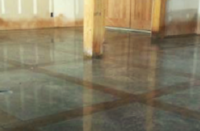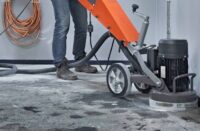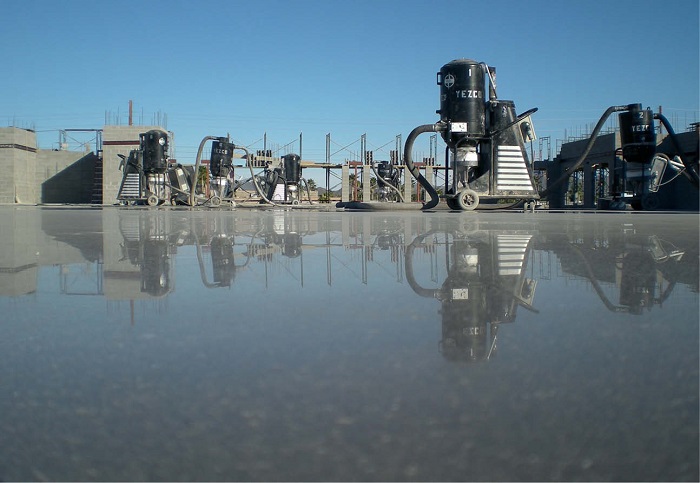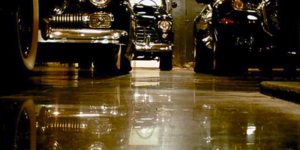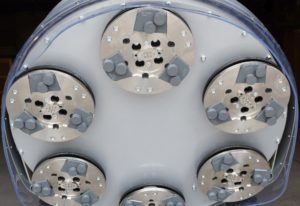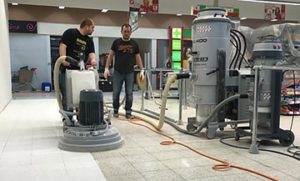As polished concrete becomes more mainstream for floors, it continues to gain momentum across the board. In fact, industry statistics show that it is now 15-20% of the total flooring installed each year.
For decades, most architects, general contractors and facility owners tended to lump floor covering/flooring and polished concrete into the same category. This was usually as division 9 (finishes). They did this because they didn’t commonly consider the differences. Due to the flooring industry’s significant efforts to educate (and provide proper specifications to) architects, contractors and owners, these client groups now (mostly!) categorize polished concrete under division 3, right where they belong.
Defining the categories
“Floor covering” and “flooring” are terms that generically describe any finish material applied over a floor structure to provide a walking surface. It’s common to use these terms interchangeably.
The working definition for “concrete flooring” is an exposed concrete floor that provides a flat, durable finish and walking surface. It can appear utilitarian or architectural, depending upon the installation techniques and the finishing processes.
Some back story
For the greater part of a decade, architects and specifiers called out “polished concrete” as a type of flooring. However, at that time, the product and process had no real standards. Contractors were bidding a variety of processes that looked like shiny concrete, such as waxing, installing clear epoxy or acrylic sealer or, in some cases, even grinding, honing and polishing a concrete floor (the real deal).
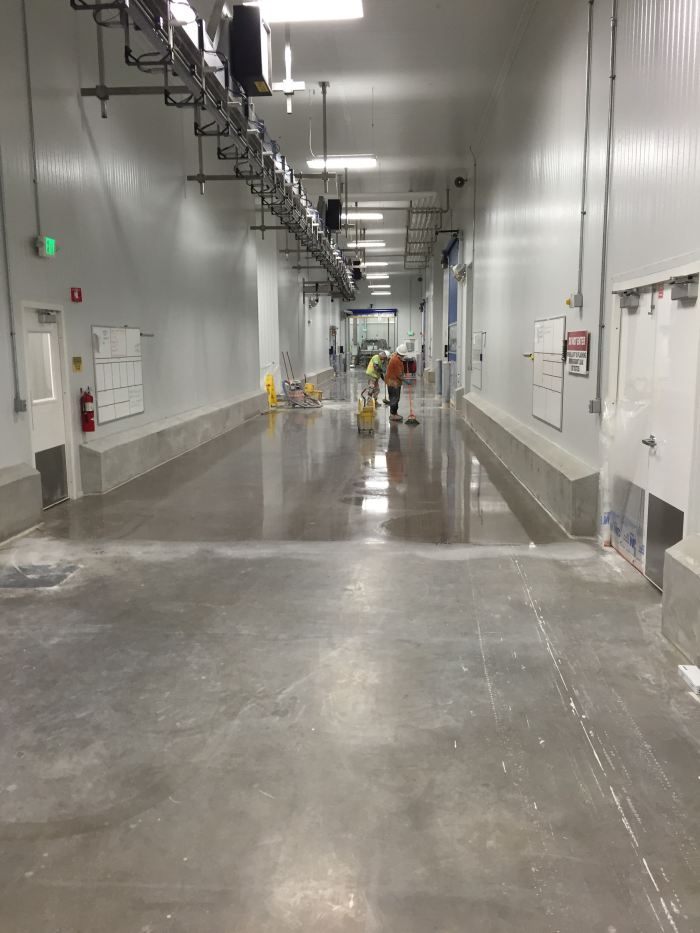
These floors produced dramatically different results and square-foot pricing, ranging from $0.50/square foot to $7 or more. Imagine the confusion this caused about polished concrete. For the real polished concrete industry to survive, skilled polishers, technicians and vendors formed an association. Polished concrete was defined and standards were developed.
The Concrete Polishing Council weighs in
The Concrete Polishing Council, the industry’s association, now agrees that polished concrete is a process of progressive grinding, honing, densifying and polishing that refines a concrete surface into an aesthetically pleasing, highly durable, light-reflective, dustproof, safe and functional floor finish.
The CPC defines polished concrete as the act of permanently changing a concrete surface, with or without aggregate exposure, to achieve a specified appearance level. This definition was developed out of necessity! In fact, there are now three subcategories, as well: bonded abrasive, hybrid and burnished polished concrete.
Due to the increase of polished concrete’s quality and number of installations, it’s becoming important for floor covering contractors, designers, site owners and consumers to learn more about what it is, along with its pros and cons. With an agreed upon working definition of floor covering and polished concrete, we can now share some reasons why polished concrete is so popular and desirable and why it’s replacing some of floor coverings’ normal uses and is an accepted alternative.
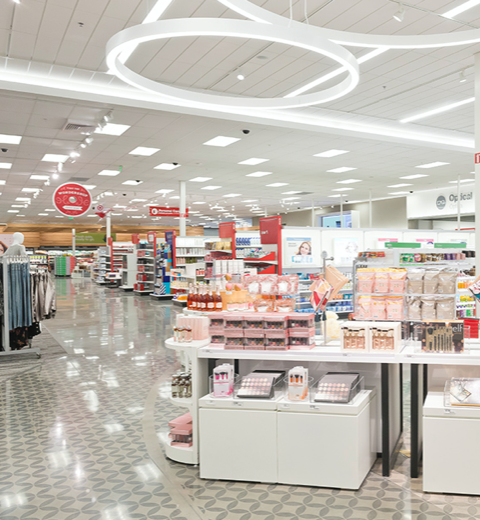
A ‘new’ idea in flooring
Polished concrete is perceived as a new idea (flooring option), which back in 1996 it really was. Researchers have studied “idea generation” and they explain that ideas go through phases. Polished concrete now meets all four of these phases:
Make it relevant
Polished concrete has a certain relevant aesthetic and at the same time a casual attitude that attracts people. Designers are frequently making it their focal point. You can integrally color it when it’s poured or topically color it during the installation process.
Prove it
Since concrete is one of the most used building materials on the planet, it’s frequently already scheduled as part of the building structure. Using what’s already there becomes an easy choice, depending upon the use and image needed. Value engineering and sustainability are driving this desire, resulting in greater usage frequency, popularity and general acceptance.
Large box retailers started using it in the late 1990s and, as of last year, Target made polished concrete a significant piece of its design concept. Target actually resisted until it had proof that its customers would continue to shop in the stores without bright-white VCT. They realized that concrete polishing is the right idea for stores like theirs. Target’s conclusion was that this flooring type is saleable.
Make it safe
Polished concrete suggests a shiny floor, so there’s always been a safety concern that it would be slippery, unsafe and, frankly, a liability. Since polished concrete has been in the mainstream of commercial building floor choices for more than 10 years, our clients have learned that it’s a safe flooring choice and that people slip less for several reasons.
One is the visual difference. Ceramic tile or VCT floors remain the same color when wet. Since these floors don’t wet out or darken, pedestrians can’t readily see the changed condition. Conversely, since polished concrete has squillions of pores at the surface which absorb enough liquid to leave a visible darker area, pedestrians can see the change and react accordingly.
Extensive research has measured the coefficients of friction on a wide range of walking/working surfaces. Results clearly show that polished concrete is among the safest of floors, no matter the shine level or aggregate exposure level. This research was discussed at length in an article titled “New Research Says Polished Concrete is the Most Slip-Resistant Flooring” in the February/March 2014 edition of Concrete Decor magazine.
Show it is saleable
Finally, polished concrete is saleable, especially since becoming a top choice for the architecture and design community and the younger generations. Recently, two publications I get, a CB2 catalog and Modern Steel Construction, even featured it on their covers. And Amazon shared that its distribution centers received a polished (low sheen) treatment that is durable, dustproof and highly functional.
Polished concrete has now met the criteria of all four phases of idea generation. It’s relevant, there’s proof it’s an acceptable floor, it’s safe, it’s saleable and people like it. It’s no longer a question of will it be used, it’s more about where.
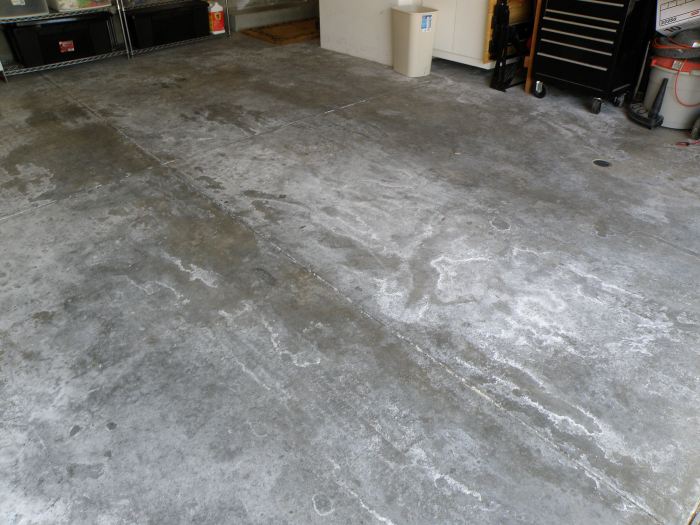
Plenty of pluses
Polished concrete is permanent. Additionally, it has a unique/natural look and once installed you cannot easily remove. Of course, you can cover it with a floor covering or physically abrade the surface if you require a change. It’s sustainable and may contribute points toward a LEED certification. It’s highly durable and is ideal for high-traffic environments due to surface refinement during installation.
Additionally, the installation process results in a flatter/smoother floor and provides greater traction. This makes it a good choice for vehicular traffic, with less vibration to equipment, fewer employee injuries and easier level object placement. Polished concrete has a low life-cycle cost due to its permanency, ease of repair, maintenance and cleaning. This makes it more sanitary (no grout) and, if clean, won’t act as a host for mold.
Polished concrete is breathable, which eliminates the MVER concern. However, it can still experience a temporary side effect from moisture drive called efflorescence which appears as a whitish powder on the surface.
Concrete also has a high-thermal mass providing inertia against temperature fluctuations and its ingredients are chemically inert and virtually noncombustible. It also doesn’t emit VOCs during any part of its life cycle, and there’s no “new polished concrete” smell. It can even be a low-cost installation when in a larger footprint and can appear industrial or aesthetically beautiful.
Still, it’s not for every job
Along with the many features and benefits of concrete polishing, it’s also important to understand when it’s not the answer.
This flooring type does not provide sound absorption, texture, luxury, incredible variety, warmth, comfort, cushion and design warmth. It also does not provide the ability to cover up concrete problems, controlled manufacturing or predictable results.
Polished concrete also isn’t good for continually wet surfaces, floors that have exposure to harsh chemicals, areas used for containment or spaces that require sound dampening. It is also not great in a space that requires grounding, walk-off areas, or soft, extensively damaged or uneven slabs. You must select floor coverings or coatings for these uses or when clients simply desire a floor covering.
Here to stay
There is room for all types of flooring. Knowing these characteristics and having a well-versed understanding of both floor coverings and polished concrete flooring will better prepare you to discuss flooring options.
I’m proud of how far this industry has come in a short time. We’ve become better stewards of our craft, learned from our mistakes and believe in what we do. Those things have earned concrete polishing a very good reputation. When it is done right, it is here to stay!
